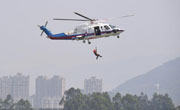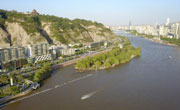Why do we have more frequent and intensive sandstorms this year?
On the first workday after the Labor Day holiday, Beijing and other northern areas in China saw another sandstorm. On the night of May 6, the National Meteorological Center continued to issue a blue warning for sandstorms, which forecast 13 regions including Beijing, Tianjin, and Hebei province would be hit by a sandstorm between 8 p.m. on May 6 to 8 p.m. on May 7. Parts of Inner Mongolia would experience a strong sandstorm.
Why have northern regions been continuously hit by sandstorms this year? Gui Hailin, chief forecaster at the National Meteorological Center says it is mainly caused by cold air gales. Recently, active cold air in mid-to-high altitudes in Eurasia continued to head south. Under this impact, Beijing encountered windy weather from May 6 to 8. Wind power was strongest during daytime on May 6, which is accompanied by sand and dust.
"There are many weather systems that generate strong winds, such as surface cold air, cyclone, typhoon, and meso- to micro-scale convection systems. They are all capable of forming windy weather processes," says Chen Tao, the center’s chief forecaster. "This year, the high wind weather is closely related to the cyclone activities in Mongolia. During springtime, plateau areas in Mongolia have higher average temperature and low precipitation. Bare ground with little vegetation will easily form a low pressure system. Under the coordination of cold air activity and other weather conditions, strong cyclone development can easily form in Mongolia. This year, cyclonic activities are quite frequent in Mongolia, which has an obvious impact on the northern regions in our country."
A specialist with the center says, since springtime this year, the sandstorms in our country have been more frequent and more intensive, the total number of sandstorms and heavy sandstorms recorded so far have been the most since 2013. This will affect the punctual and safe operation of roads, railways, aircrafts and ships. High wind weather will also bring regional floating dust, flying sand, or sandstorm weather, impacting air quality and visibility. The general public should pay attention to the warning information published by the meteorological department on time, avoid outdoor activities during high wind weather. The elderly, children, and people with respiratory allergies should avoid outdoor activities. If they do, they should wear masks, scarves, or other dust prevention products, and wash their faces and nasal cavity when they get back.
Contributed by: Yuan Yufei, reporter of Guangming Daily
[ Editor: JYZ ]










More From Guangming Online
Medics from Fujian leave for Shanghai to aid in battle against COVID-19 resurgence
New int'l land-sea transport service to Indo-China Peninsula launched
Another makeshift hospital under construction in Shanghai
Tourists view tulips in Suiping County, Henan
In pics: blooming gagea flowers on grassland in Zhaosu, Xinjiang
Greek workers stage 24-hour general strike over high prices